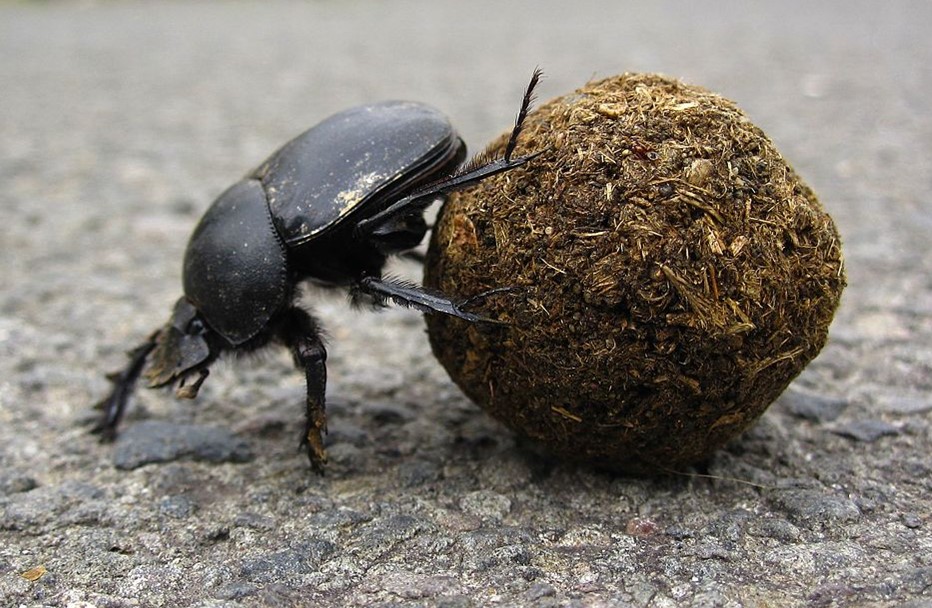
Credit: Tashkoskim, via Wikimedia Commons
Dung beetles. Scientists think they evolved 150 million years ago, along with flowering plants, which had become the main food of herbivorous dinosaurs.
Much of the plant matter passed through the dinosaurs’ guts, producing huge volumes of poop with some nutritive value—for a new kind of beetle to capitalize on.
Today, there are 8,000 species completely dependent on dung. They eat it, make homes of it, and lay their eggs in it so their hatchlings will have food.
Some species live in the dung. Others tunnel under it, to pull it into their burrows. The most famous make big balls of it and roll them away for safe keeping.
But first, they climb on top of the ball and do a little dance. Scientists think they’re taking a “photo” of the sky to orient themselves.
They then push the ball off at top speed, to avoid it being stolen by another hungry dung beetle.
If they get knocked off course, they climb back on the ball, reorient themselves to the sky, and carry on.
They can orient to the sun, the moon, and when there are neither of these, even the Milky Way.
Researchers have even put dung beetles in planetariums, and they’ve navigated just fine to the projected galaxy.
But when they blindfolded the beetles, they couldn’t orient at all and just pushed their dung balls around in circles.
Dung beetles’ chosen food, and their single-minded dedication to it, may seem funny to us. But like other nocturnal animals, from frogs to seals, they are amazing animal astronomers.
Background
Synopsis: Revered by ancient Egyptians, scarab beetles have been around since the days of dinosaur dung, more than 150 million years ago. These beetles prefer the dung of herbivores: some rolling dung balls to safety, while others tunnel under dung piles, and yet others simply live in the dung. Recent studies have shown that dung rollers navigate their smelly spheres in at least three ways, using the sun, the moon, the wind, and, if those don’t work, the Milky Way.
- Scientists recently sequenced the DNA of scarab, or dung, beetles, placing their origins at about 115 to 130 million years ago in the Lower Cretaceous Epoch.
- Fossils in Kazakhstan and China may push that date back even farther into the very end of the Jurassic Period.
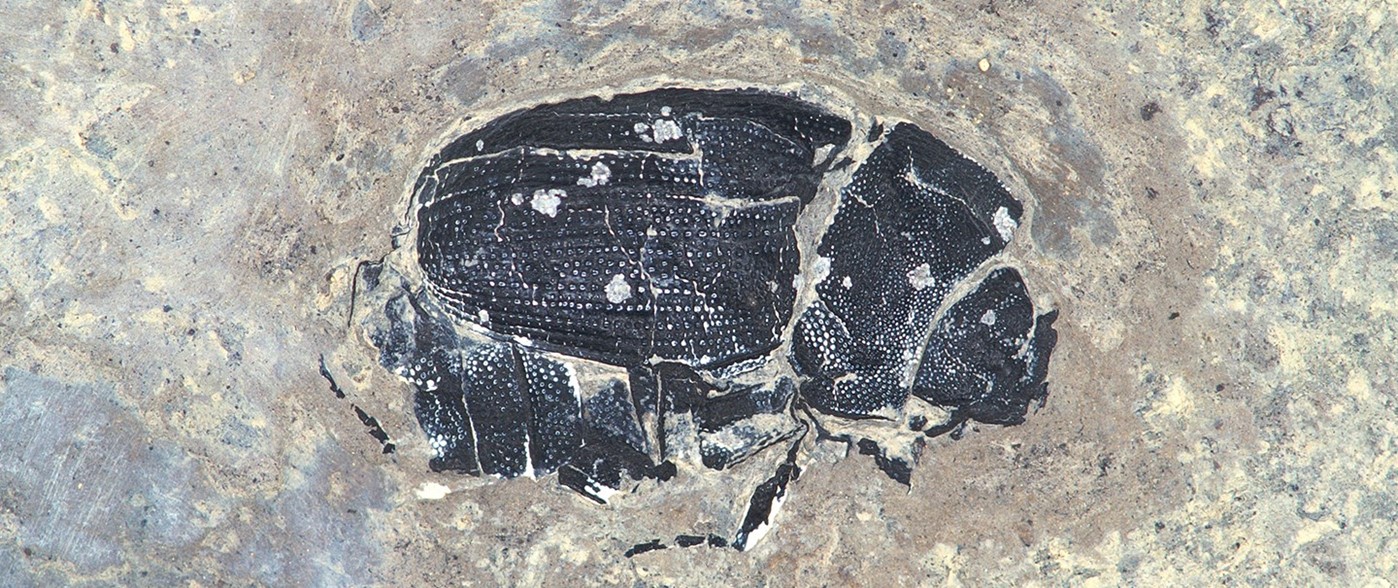
Scarab and stag beetles (Coleoptera: Scarabaeoidea) are particularly hard-shelled beetles that appeared as far back as the Jurassic fossil record, evolving into one of the largest beetle superfamilies.
Credit: Denver Museum of Natural Science - With the rise of angiosperms occurring around the same time (ED-061 Stories Hidden in Pollen), scientists hypothesize that the beetles flourished as herbivorous dinosaurs began to incorporate flowering plants into their diets, much of which passed through their digestive tracts into their prolific piles of poo.
- Tunnels attributed to dung beetle feeding have been found in the fossilized dung of Upper Cretaceous plant-eating dinosaurs from 70 to 80 million years ago.
- Fossils in Kazakhstan and China may push that date back even farther into the very end of the Jurassic Period.
- Today, close to 8,000 species of dung beetles are found in habitats ranging from forest to desert on every continent except Antarctica.
- Dung beetles range from 0.08 to 6.7 inches (0.2–17 cm) long and may weigh up to 3.5 oz (99 g). Their brain is the size of a sesame seed or smaller.
- As coprophagous organisms, their whole life cycle revolves around dung. They incorporate it into their homes, consume it, and lay their eggs in it so that dung beetle hatchlings have dung to devour as they grow.
- They serve as the sanitation engineers and gardeners of their habitats cleaning up after herbivores and stashing dung underground away from pests like flies where it serves as fertilizer and disperses seeds.
- Dung beetles use scent detectors on the ends of their antennae to find new manure piles.
- Some can excavate up to 250 times their own weight of dung in a single night.
- Their favorite dung comes from herbivores, but some species will also consume excrement from omnivores.
- Competition for dung is intense, as hundreds of dung beetles may rush to a single pile of poo. Some ride on large animals anticipating a fresh meal.
- Modern dung beetles fall into three groups, all strategically focused on getting their hoard of dung stashed away for safe keeping.
- Dung dwellers immerse themselves in it, living in dung piles.
- Dung tunnelers burrow under dung piles to access the dung from below, storing it in their tunnels. Many have large horns used for protecting their hoards.
- Dung rollers grab a chunk of dung and shape it into a sphere, then roll it as quickly as possible away from the commotion in the pile to bury them for later.
- Dung rollers, the best-known group, can roll dung balls ten times their weight and have four different ways to navigate. There are 600 species of dung rollers.
- They must move in a straight line away from the pile to minimize the chances of having their ball stolen by other beetles.
- Their ball rolling journeys typically take just 6 to 7 minutes unless they get caught in one of the many judo-like fights that occur in the dung pile.
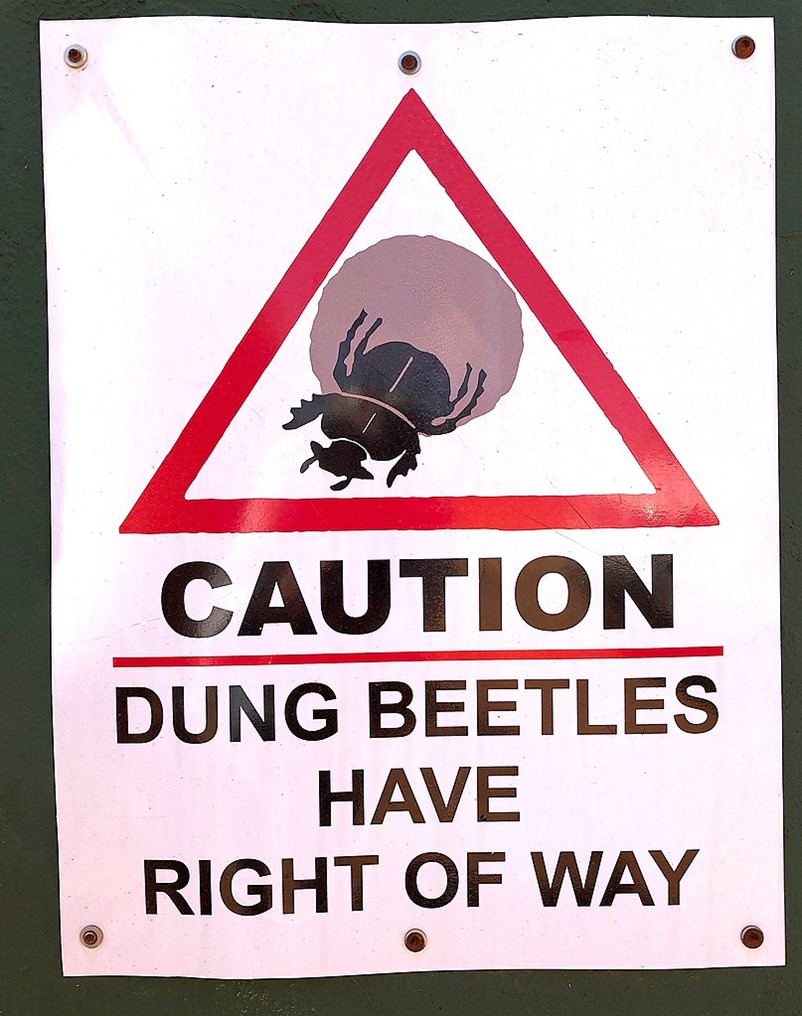
Caution dung beetles, South Africa.
Credit: Olga Ernst, via Wikimedia Commons - Before they start rolling, dung rollers perform a dance atop their ball by rotating 360 degrees, then push the ball in their chosen direction.
- If they lose control of their super-sized balls of dung, they stop and repeat the dance to reorient themselves.
- Scientists believe they may initially take a reference “snapshot” of the sky and use the memory of orientations to adjust their route along the way.
- They use the sun to plot a course straight to a waiting burrow, using special photoreceptors in their eyes that create symmetrical patterns of polarized sunlight.
- When the sun is high, beetles can’t use it for navigation, so some species roll their balls based on the direction of wind, using the lower part of their antennae to feel the wind.
- When the sun goes down, they use polarized light from the moon to navigate.
- But on moonless nights, some of these little astronomers (Scarabaeus satyrus) can navigate in a line relative to the bright strip of the Milky Way, the only non-human animal known to use our galaxy for navigation.
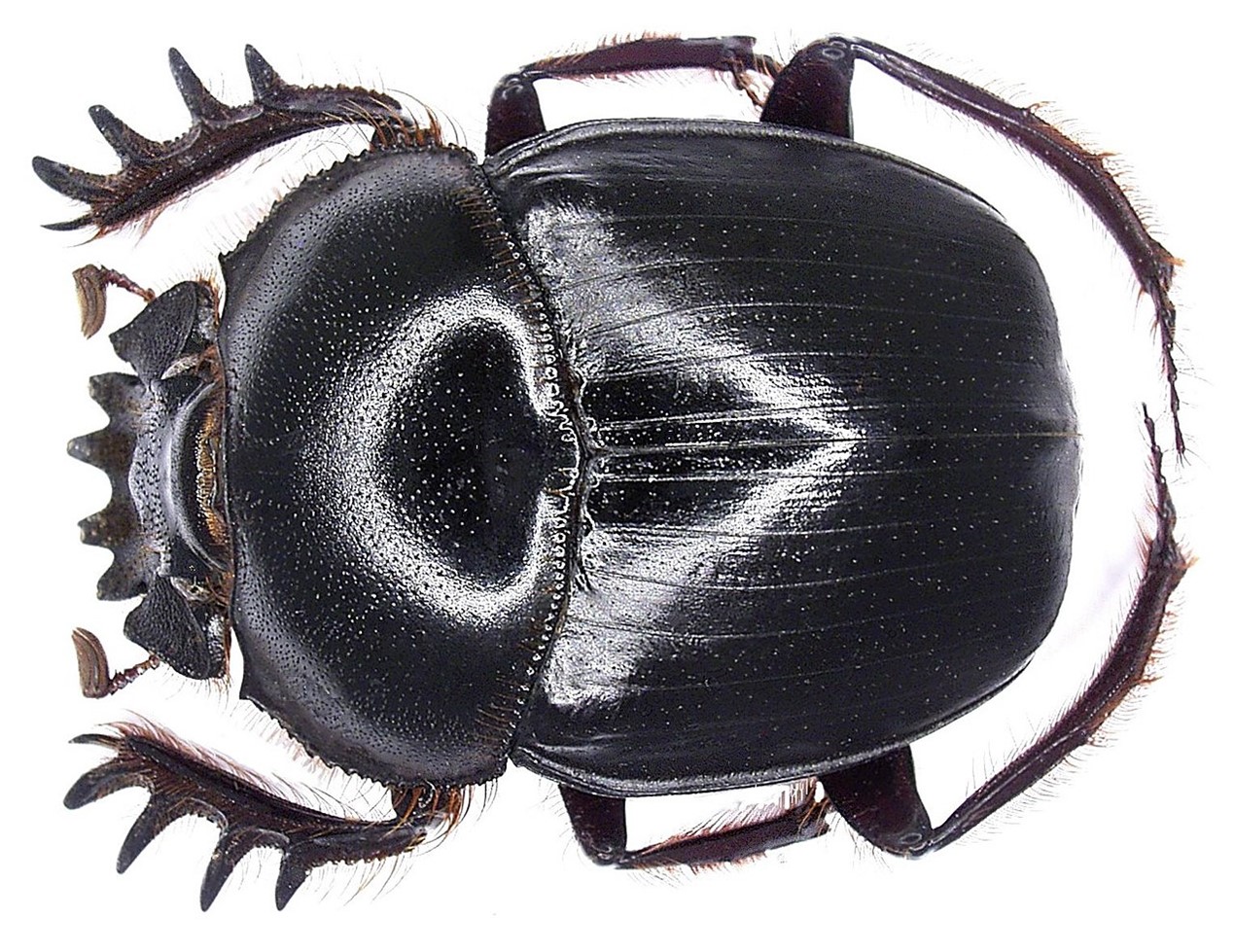
This inch long (2.5 centimeter) Namibian Scarabaeus satyrus can distinguish between the north and south arms of the Milky Way to plot courses and navigate.
Credit: Udo Schmidt from Deutschland, via Wikimedia Commons- Scientists strapped little hats on the patient (and forgiving) insects when the moon was not visible and found that the beetles just wander in circles with the hats on.
- They also tested the beetles out in a planetarium with a projected Milky Way, and they navigated the same as they did outside.
- They can only find their way if they have a view of the Milky Way.
- Light pollution near urban centers creates confusion for dung rollers as it drowns out the moon and Milky Way that are critical to their navigation.
- In ancient Egypt, the dung roller beetle now known as Scarabaeus sacer was revered as one of the sacred manifestations of the sun god.
- Ancient Egyptians believed the beetles mimicked the sun's motion by rolling dung balls on the sand and burying them, like sunset.
- The scarab beetle was a good luck symbol, representing hope, immortality, protection and representing the circle of life.
- The scarab-faced morning sun god Khepri is associated with rebirth and the rising or newborn sun.
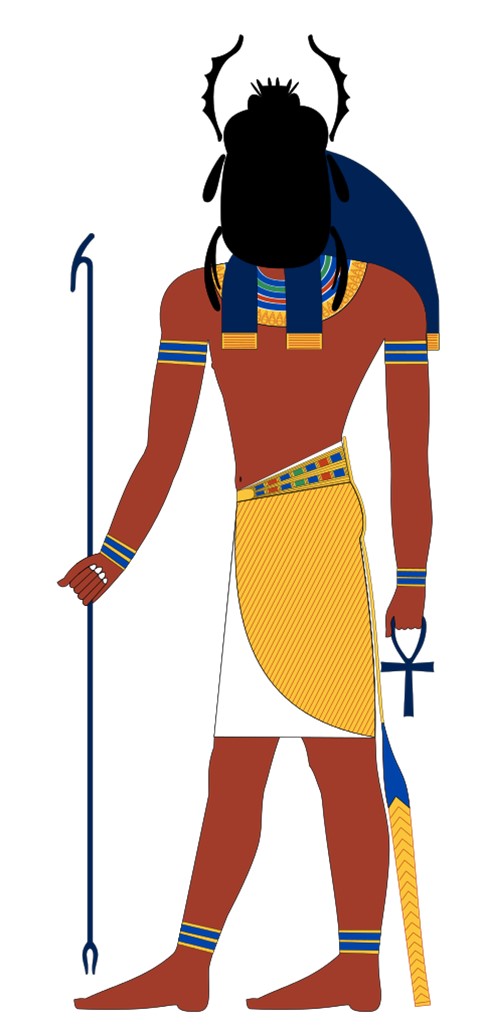
An image of the god Khepri, the Egyptian god of the morning sun who also represents creation and the renewal of life. Khepri was the morning subordinate to Ra, while Atum was the evening subordinate.
Credit: Jeff Dahl, via Wikimedia Commons - Representations of scarab beetles were used as amulets and for ritual or administrative purposes and were traded throughout the Mediterranean world.
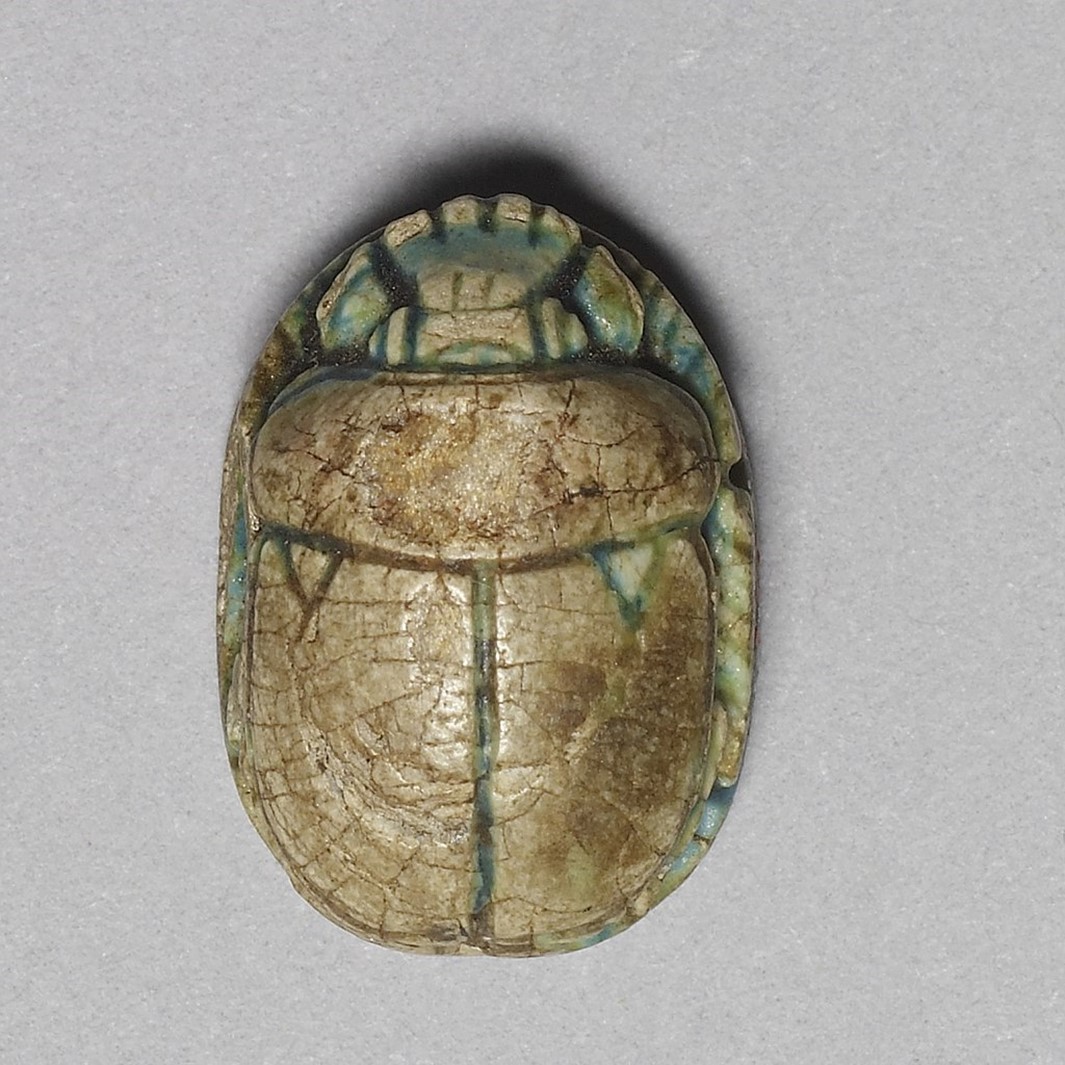
This scarab is inscribed with the name of the female pharaoh Hatshepsut along with her relation to the sun god.
Credit: Walters Art Museum, public domain, via Wikimedia Commons - While working near Cairo on a 4,500-year-old tomb in the Saqqara necropolis in 2018, archaeologists found two limestone boxes of mummified scarab beetles, the first ever discovered. One sarcophagus had a decorated, vaulted lid and contained two beautifully preserved large beetles, one male and one female, wrapped in linen. The other smaller sarcophagus was separated into three layers and contained around 200 smaller mummified scarabs.
- You can play Dung Beetle Derby on the National Geographic Kids website. Try it!

